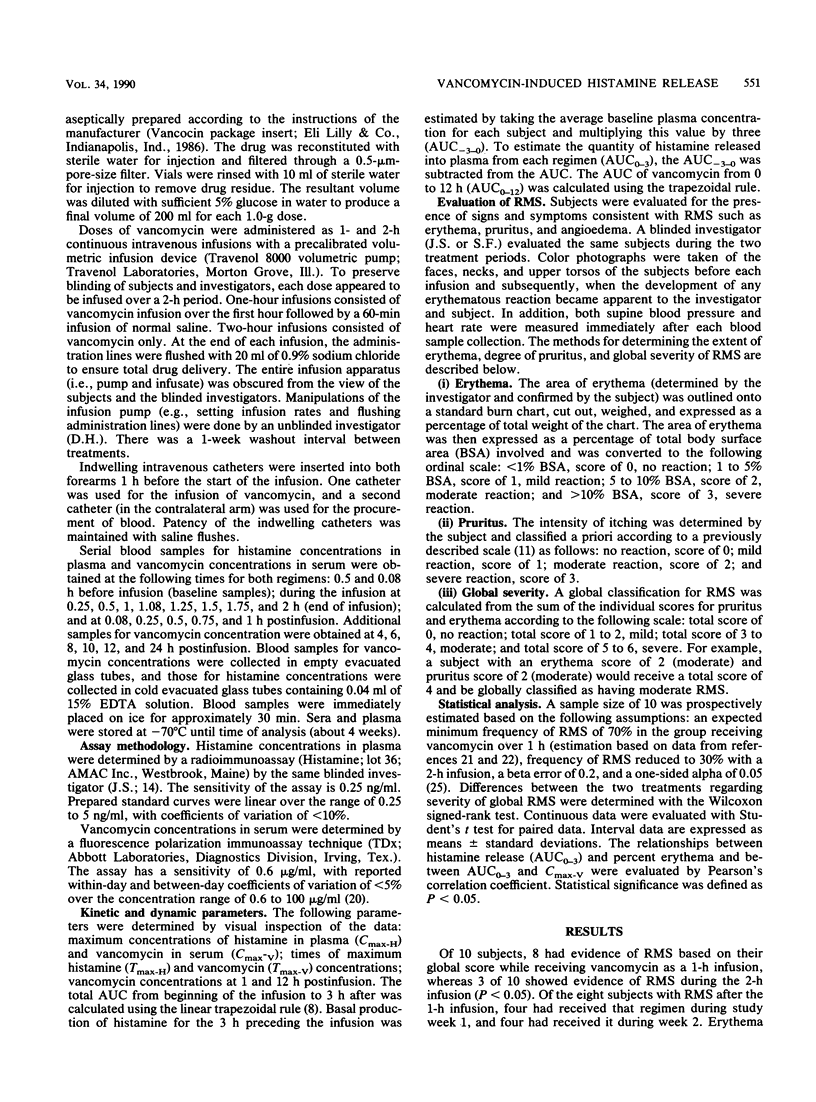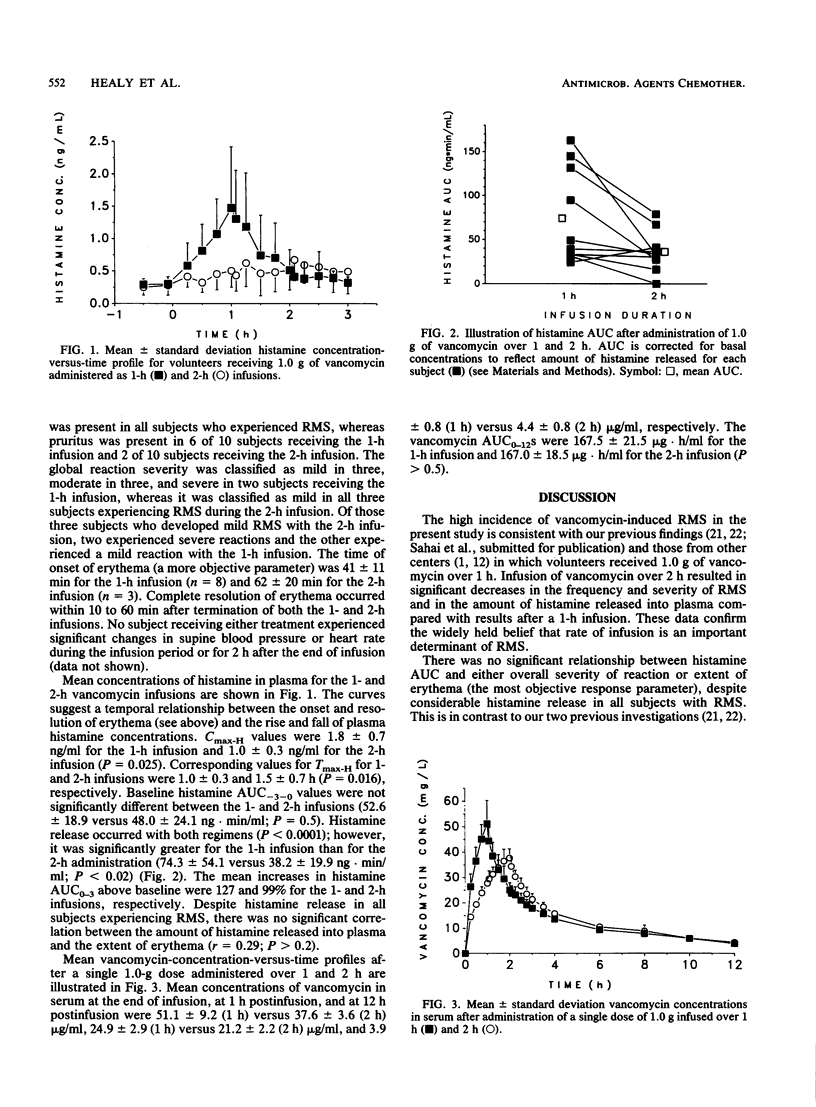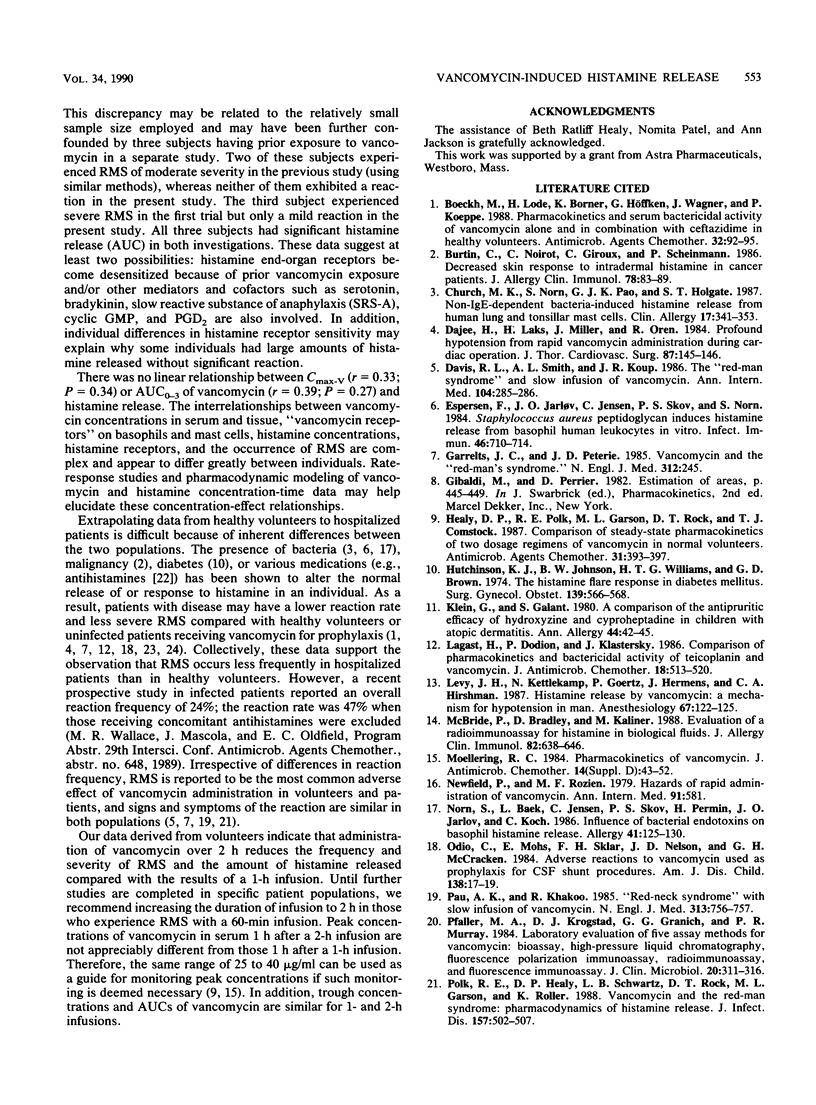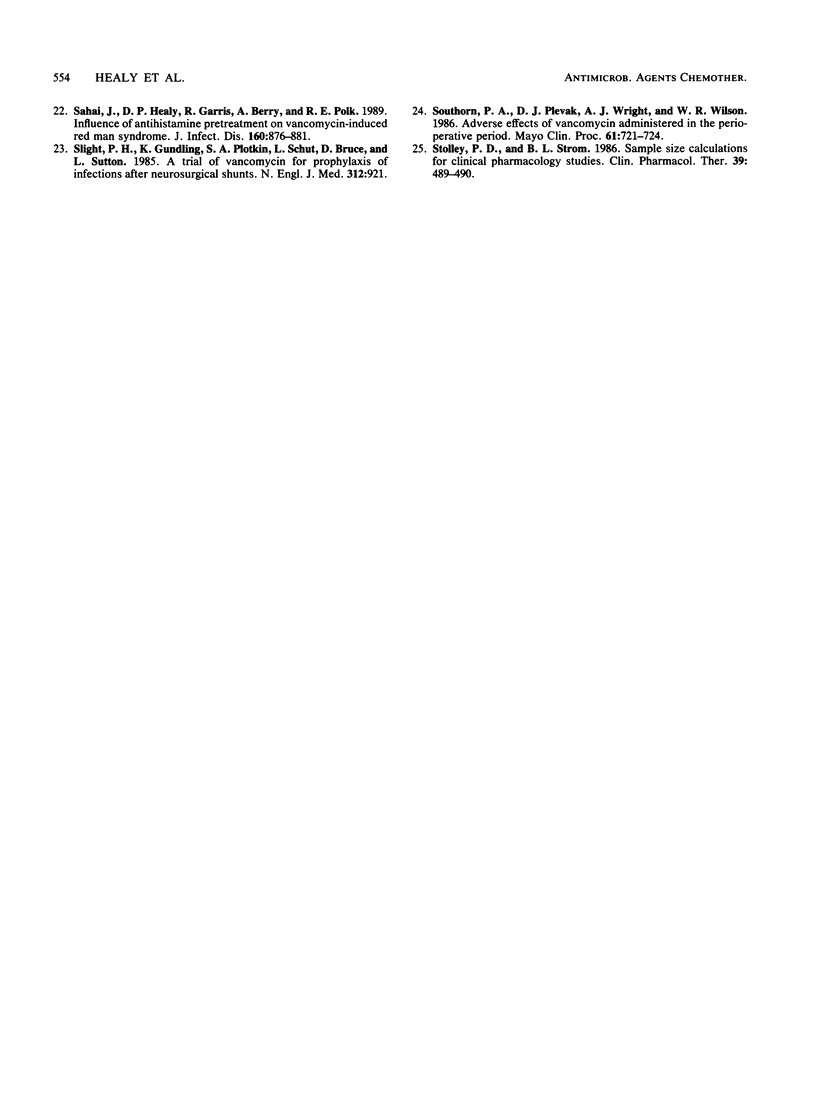Abstract
Vancomycin-induced "red man syndrome" (RMS) is mediated in part by histamine release, and its severity is correlated with the area under the plasma histamine concentration-time curve. Ten adult male volunteers participated in a randomized, double-blind, two-way crossover trial (1-week washout interval between regimens) to determine the effect of 1- and 2-h infusions of vancomycin (1.0 g) on histamine release and on the frequency and severity of RMS. The severity of RMS was classified a priori as mild, moderate, or severe from a combined score of pruritus and extent of erythema. Serial concentrations of histamine in plasma and concentrations of vancomycin in serum were measured at baseline and during and after each infusion. Of 10 subjects, 8 had evidence of RMS during the 1-h infusion (3 mild, 3 moderate, and 2 severe), whereas only 3 of the 10 subjects (all mild) had RMS during the 2-h infusion (P less than 0.05). The 1-h infusion was associated with a significantly greater peak concentration of histamine in plasma (1.8 +/- 0.7 versus 1.0 +/- 0.3 ng/ml, P = 0.004) and a greater total release of histamine (74.3 +/- 54.1 versus 36.4 +/- 22.6 ng.min/ml, P = 0.017) than was the 2-h infusion. These data suggest that administration of vancomycin over 2 h reduces the frequency and severity of RMS and the amount of histamine released compared with those after a 1-h infusion in healthy volunteers.
Full text
PDF




Selected References
These references are in PubMed. This may not be the complete list of references from this article.
- Boeckh M., Lode H., Borner K., Höffken G., Wagner J., Koeppe P. Pharmacokinetics and serum bactericidal activity of vancomycin alone and in combination with ceftazidime in healthy volunteers. Antimicrob Agents Chemother. 1988 Jan;32(1):92–95. doi: 10.1128/aac.32.1.92. [DOI] [PMC free article] [PubMed] [Google Scholar]
- Burtin C., Noirot C., Giroux C., Scheinmann P. Decreased skin response to intradermal histamine in cancer patients. J Allergy Clin Immunol. 1986 Jul;78(1 Pt 1):83–89. doi: 10.1016/0091-6749(86)90118-1. [DOI] [PubMed] [Google Scholar]
- Church M. K., Norn S., Pao G. J., Holgate S. T. Non-IgE-dependent bacteria-induced histamine release from human lung and tonsillar mast cells. Clin Allergy. 1987 Jul;17(4):341–353. doi: 10.1111/j.1365-2222.1987.tb02024.x. [DOI] [PubMed] [Google Scholar]
- Dajee H., Laks H., Miller J., Oren R. Profound hypotension from rapid vancomycin administration during cardiac operation. J Thorac Cardiovasc Surg. 1984 Jan;87(1):145–146. [PubMed] [Google Scholar]
- Davis R. L., Smith A. L., Koup J. R. The "red man's syndrome" and slow infusion of vancomycin. Ann Intern Med. 1986 Feb;104(2):285–286. doi: 10.7326/0003-4819-104-2-285_2. [DOI] [PubMed] [Google Scholar]
- Espersen F., Jarløv J. O., Jensen C., Skov P. S., Norn S. Staphylococcus aureus peptidoglycan induces histamine release from basophil human leukocytes in vitro. Infect Immun. 1984 Dec;46(3):710–714. doi: 10.1128/iai.46.3.710-714.1984. [DOI] [PMC free article] [PubMed] [Google Scholar]
- Garrelts J. C., Peterie J. D. Vancomycin and the "red man's syndrome". N Engl J Med. 1985 Jan 24;312(4):245–245. [PubMed] [Google Scholar]
- Healy D. P., Polk R. E., Garson M. L., Rock D. T., Comstock T. J. Comparison of steady-state pharmacokinetics of two dosage regimens of vancomycin in normal volunteers. Antimicrob Agents Chemother. 1987 Mar;31(3):393–397. doi: 10.1128/aac.31.3.393. [DOI] [PMC free article] [PubMed] [Google Scholar]
- Hutchison K. J., Johnson B. W., Williams H. T., Brown G. D. The histamine flare response in diabetes mellitus. Surg Gynecol Obstet. 1974 Oct;139(4):566–568. [PubMed] [Google Scholar]
- Lagast H., Dodion P., Klastersky J. Comparison of pharmacokinetics and bactericidal activity of teicoplanin and vancomycin. J Antimicrob Chemother. 1986 Oct;18(4):513–520. doi: 10.1093/jac/18.4.513. [DOI] [PubMed] [Google Scholar]
- Levy J. H., Kettlekamp N., Goertz P., Hermens J., Hirshman C. A. Histamine release by vancomycin: a mechanism for hypotension in man. Anesthesiology. 1987 Jul;67(1):122–125. doi: 10.1097/00000542-198707000-00026. [DOI] [PubMed] [Google Scholar]
- McBride P., Bradley D., Kaliner M. Evaluation of a radioimmunoassay for histamine measurement in biologic fluids. J Allergy Clin Immunol. 1988 Oct;82(4):638–646. doi: 10.1016/0091-6749(88)90977-3. [DOI] [PubMed] [Google Scholar]
- Moellering R. C., Jr Pharmacokinetics of vancomycin. J Antimicrob Chemother. 1984 Dec;14 (Suppl 500):43–52. doi: 10.1093/jac/14.suppl_d.43. [DOI] [PubMed] [Google Scholar]
- Newfield P., Roizen M. F. Hazards of rapid administration of vancomycin. Ann Intern Med. 1979 Oct;91(4):581–581. doi: 10.7326/0003-4819-91-4-581. [DOI] [PubMed] [Google Scholar]
- Norn S., Baek L., Jensen C., Skov P. S., Permin H., Jarløv J. O., Koch C. Influence of bacterial endotoxins on basophil histamine release. Potentiation of antigen- and bacteria-induced histamine release. Allergy. 1986 Feb;41(2):125–130. doi: 10.1111/j.1398-9995.1986.tb00288.x. [DOI] [PubMed] [Google Scholar]
- Odio C., Mohs E., Sklar F. H., Nelson J. D., McCracken G. H., Jr Adverse reactions to vancomycin used as prophylaxis for CSF shunt procedures. Am J Dis Child. 1984 Jan;138(1):17–19. doi: 10.1001/archpedi.1984.02140390009004. [DOI] [PubMed] [Google Scholar]
- Pau A. K., Khakoo R. "Red-neck syndrome" with slow infusion of vancomycin. N Engl J Med. 1985 Sep 19;313(12):756–757. doi: 10.1056/NEJM198509193131214. [DOI] [PubMed] [Google Scholar]
- Pfaller M. A., Krogstad D. J., Granich G. G., Murray P. R. Laboratory evaluation of five assay methods for vancomycin: bioassay, high-pressure liquid chromatography, fluorescence polarization immunoassay, radioimmunoassay, and fluorescence immunoassay. J Clin Microbiol. 1984 Sep;20(3):311–316. doi: 10.1128/jcm.20.3.311-316.1984. [DOI] [PMC free article] [PubMed] [Google Scholar]
- Polk R. E., Healy D. P., Schwartz L. B., Rock D. T., Garson M. L., Roller K. Vancomycin and the red-man syndrome: pharmacodynamics of histamine release. J Infect Dis. 1988 Mar;157(3):502–507. doi: 10.1093/infdis/157.3.502. [DOI] [PubMed] [Google Scholar]
- Sahai J., Healy D. P., Garris R., Berry A., Polk R. E. Influence of antihistamine pretreatment on vancomycin-induced red-man syndrome. J Infect Dis. 1989 Nov;160(5):876–881. doi: 10.1093/infdis/160.5.876. [DOI] [PubMed] [Google Scholar]
- Slight P. H., Gundling K., Plotkin S. A., Schut L., Bruce D., Sutton L. A trial of vancomycin for prophylaxis of infections after neurosurgical shunts. N Engl J Med. 1985 Apr 4;312(14):921–921. doi: 10.1056/NEJM198504043121416. [DOI] [PubMed] [Google Scholar]
- Southorn P. A., Plevak D. J., Wright A. J., Wilson W. R. Adverse effects of vancomycin administered in the perioperative period. Mayo Clin Proc. 1986 Sep;61(9):721–724. doi: 10.1016/s0025-6196(12)62773-6. [DOI] [PubMed] [Google Scholar]
- Stolley P. D., Strom B. L. Sample size calculations for clinical pharmacology studies. Clin Pharmacol Ther. 1986 May;39(5):489–490. doi: 10.1038/clpt.1986.85. [DOI] [PubMed] [Google Scholar]


